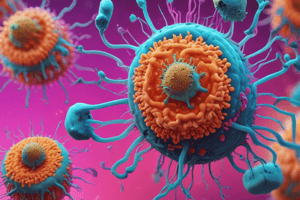Podcast
Questions and Answers
What is the main characteristic of viruses that makes them unique from other infectious agents?
What is the main characteristic of viruses that makes them unique from other infectious agents?
- They can replicate outside of a living host
- They have a cell nucleus
- They contain only one kind of nucleic acid, either DNA or RNA (correct)
- They have organelles and cytoplasm
How do viruses display properties of living organisms?
How do viruses display properties of living organisms?
- By growing and replicating alone
- By replicating only inside living host cells (correct)
- By having a cell nucleus and organelles
- By infecting host cells and synthesizing new viruses outside the host
What are the components that make up a complete virus particle called?
What are the components that make up a complete virus particle called?
- Nucleus
- Cytoplasm
- Capsid
- Nucleocapsid (correct)
What surrounds the nucleocapsid in some viruses?
What surrounds the nucleocapsid in some viruses?
Where do the viral genome and nucleic acids lie in the virus?
Where do the viral genome and nucleic acids lie in the virus?
What type of genetic material can the viral genome contain?
What type of genetic material can the viral genome contain?
What is the function of viral proteins in a virus?
What is the function of viral proteins in a virus?
What is the composition of an envelope in viruses?
What is the composition of an envelope in viruses?
Which characteristic is associated with enveloped viruses?
Which characteristic is associated with enveloped viruses?
What determines the size and shape of most viruses?
What determines the size and shape of most viruses?
Which type of capsid has ribbon-like protein forms that spiral around the nucleic acid?
Which type of capsid has ribbon-like protein forms that spiral around the nucleic acid?
What are spikes on the envelope of some viruses primarily used for?
What are spikes on the envelope of some viruses primarily used for?
Why are enveloped viruses easily damaged by environmental conditions?
Why are enveloped viruses easily damaged by environmental conditions?
What is the function of spikes on the envelope of some viruses?
What is the function of spikes on the envelope of some viruses?
What is the primary advantage of enveloped viruses?
What is the primary advantage of enveloped viruses?
What determines the composition of an envelope in viruses?
What determines the composition of an envelope in viruses?
Flashcards are hidden until you start studying




